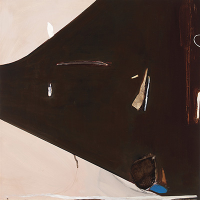BRETT WHITELEY Study for Autumn - Japanese Autumn

Brett Whiteley is most admired for the sensuous power and lyrical expressionism of his work. While his genius and individuality was expressed through an impressive range of media from printmaking to sculpture, it was painting that was the means by which he could truly make sense of the world. Whiteley himself understood that ultimately, ‘… the most fundamental reason one paints is in order to see.’1 The landscape offered him of all the subjects he painted, the greatest sense of freedom and release – his home town of Bathurst in particular was a subject of much affection.
Study for Autumn (Near Bathurst) – Japanese Autumn is the smaller-scale study of his major work entitled Autumn (Near Bathurst) – Japanese Autumn 1987-88. Unified by the vase and rich brown landscape, free-floating objects are purposefully and masterfully placed throughout the composition. In the top left-hand corner, an abstract suggestion of a white bird perches on the edge of this brown divide. It’s presence is indicative of a sense of liberty for the artist, as according to Barry Pearce, ‘Whiteley had always loved birds since childhood and in his last phase of work, they became symbols of both domesticity and freedom.’2 Additional fragments of the landscape such as water and vegetation are suspended along the outer edges in this tranquil composition. ‘Whiteley developed an acute ability for activating large, empty spaces by sensitive disposition of forms or lines huddled around the edges.’3
This spacious and uncluttered landscape combines Whiteley’s two major influences of abstraction – the free floating shapes of British artist, William Scott, and the sensitivity of form and colour of American-Japanese artist, Kenzo Okada, whom he had long admired. ‘Okada’s work has an important reference for Whiteley’s early abstraction as well as his later preoccupation with Japan.’4 While this study indicates Whiteley’s preoccupation with Japanese culture and art through calligraphic depiction of a willow tree and minimalist treatment of form, at the time of the works’ execution he had not yet travelled to Asia.
He was to visit Tokyo the year following the completion of the work, in 1989.
Whiteley’s palette of earthy shades of browns, ochres and creams captures perfectly the landscape in the Bathurst region. In the execution of Study for Autumn (Near Bathurst) – Japanese Autumn, 1987-88, Whiteley once again returned to the familiarity of the landscape he knew and loved as a young boy.
Footnotes.
1. www.artquotes.net/masters/whiteley_quotes.htm
2. Ibid, p 37
3. Ibid, p 21
4. Pearce, B., Brett Whiteley: Art and Life, London: Thames & Hudson, 2004, p 21